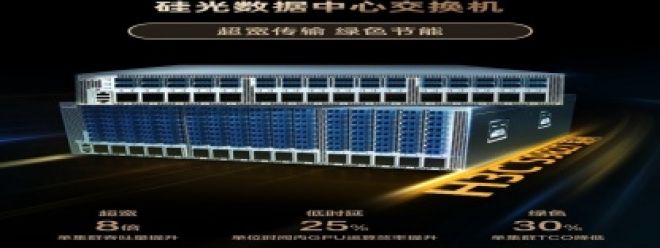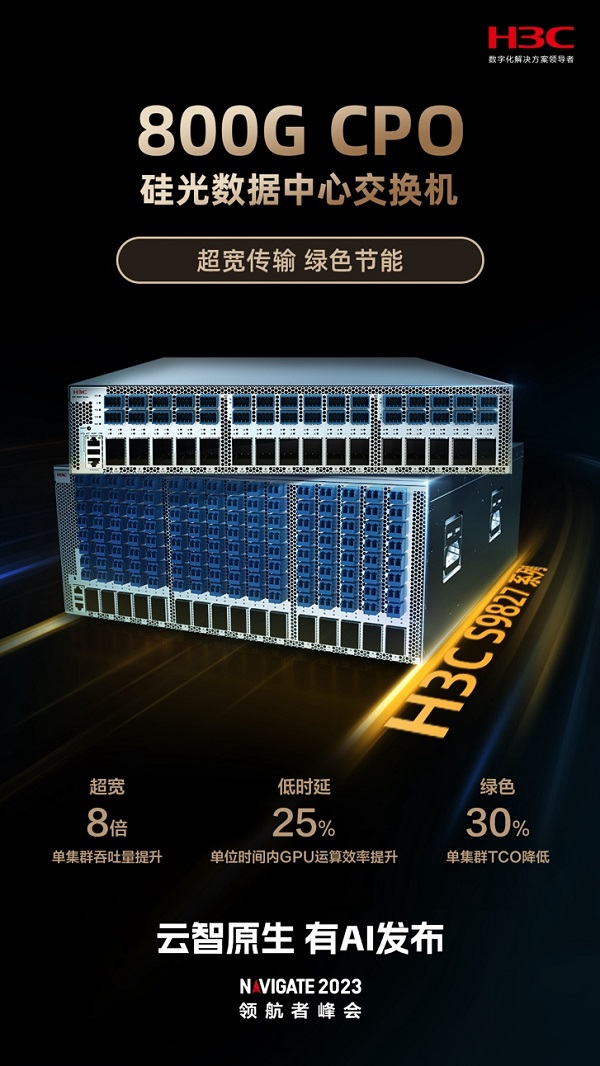World premiere! H3C Launches 800G CPO Silicon Optical Data Center Switch

World premiere! H3C Launches 800G CPO Silicon Optical Data Center Switch
Recently, at the 2023 NAVIGATE Summit, H3C Group, a subsidiary of Tsinghua Unigroup, launched a "sharp weapon" for intelligent computing networks - the world's first 51.2T 800G CPO silicon photonics data center switch (H3C S9827 series) . The single-chip bandwidth of this product is as high as 51.2T, supports 64 800G ports, and integrates advanced technologies such as CPO silicon photonics technology, liquid-cooled heat dissipation design, intelligent lossless, etc., to fully realize the three major requirements of intelligent computing network: high throughput, low latency, green energy saving, with high-quality network connections to help release the ultimate computing power in the AIGC era.

At present, AI applications are booming, and large-scale model applications have created a demand for super-large-scale computing power. The network, as the gateway and the basic support for data interaction, will accelerate the evolution towards high bandwidth, low power consumption, and low latency. Focusing on the underlying technology, the balance between high-speed transmission and low power consumption is an eternal problem. Based on energy efficiency and cost considerations, CPO (Co-packaged optics, co-packaged optics ) technology stands out, or will become the high computing power demand of AI The only way to reduce energy consumption and cost.
High throughput: The throughput of a single cluster is increased by 8 times
Due to the huge internal traffic in the data center, a non-blocking network architecture is usually adopted. This architecture is highly dependent on the speed of a single port. The overall power of the architecture produces an exponentially magnified effect. The product supports 64 800G port designs, with a single-chip bandwidth of 51.2T, which can support a single AIGC cluster with a scale exceeding 32,000 nodes, which is 8 times that of the era of 400G switches. On the basis of fully meeting the non-blocking transmission requirements of medium and large-scale AIGC clusters, it further reduces energy consumption and costs, improves stability and reliability, and simplifies network management, so as to maximize the computing performance of AIGC clusters.
Low latency: GPU computing efficiency increased by 25% per unit time
Data throughput and transmission rate are two different propositions. Data throughput refers to the total amount of data that can be transmitted through the network within a unit of time, while transmission rate usually refers to the amount of data transmitted per second. When the AIGC cluster performs distributed deep learning training, the model parameters need to be frequently synchronized between different nodes. Once the network delay problem occurs, it will have a serious impact on the training efficiency and results, so it has extremely high requirements for network delay. On the basis of high throughput, H3C S9827 reduces the single-port transmission delay by 20% based on the application of CPO silicon photonics technology, which means that the data interaction capability of the GPU in the AIGC cluster can be increased by 25% per unit time. Greatly improve the computing efficiency of GPU.
Green: "Silicon photonics + liquid cooling" fusion application achieves a 30% reduction in single-cluster TCO
As a "big energy consumer" in the digital industry, AIGC's continuous warming has also intensified the "energy consumption anxiety" of data centers. Under the guidance of the "dual carbon" strategic goal, the green and high-quality development of data centers has become the main theme. The H3C S9827 is equipped with advanced CPO silicon photonics technology, which directly spans the data signal from the traditional PCB interconnection to the optical IO interconnection, which greatly reduces the power consumption of the chip to overcome the transmission impedance, and realizes a 30% reduction in TCO in a single cluster , effectively assisting the construction of a green data center network. At the same time, the product adopts the "air cooling + liquid cooling" combination scheme for heat dissipation. The front and rear straight air ducts meet the layout requirements of the front air and rear air outlets in the computer room. The rear parallel fan frames realize N+1 redundancy of fan frames, allowing The heat dissipation of the system is more efficient and reliable; in addition, the core components of the product adopt a full liquid cooling design, and liquid cooling accounts for more than 83% of the heat dissipation, fully realizing a 30% reduction in the TCO of a single cluster.
High throughput, zero packet loss, low latency, intelligent and lossless new experience
As a "power tool" for intelligent computing networks, H3C S9827 has built-in AI ECN optimization algorithm, RDMA, intelligent speed limit, AI energy saving and many other functional modules. AI ECN can collect the characteristics of traffic of concern, ensure that the queue achieves low latency and high throughput, and satisfies centralized and distributed intelligent lossless network analysis; RDMA technology combines computing, storage, and IP network "three networks into one" to improve network throughput It reduces network latency and brings a new smart and lossless experience with high throughput, zero packet loss, and low latency.
Thick Plant Fertile Soil, Extract The Essence. New H3C Group has been deeply involved in the network for more than 20 Years, and is committed to the exploration and I nnovation of Advanced Network Technologies. The Release of the New 800GCPO Silicon Photonic Data Center Switch is Another masterpiece of New H3C to fully embrace the AIGC era and lead the transformation of data center networks. In the future, New H3C will adhere to the concept of "intensive cultivation and pragmatism, and empower the times with wisdom", continue to improve the capabilities of the cloud-native digital platform, and lay a solid foundation for intelligent connection for the high-quality development of the digital economy.